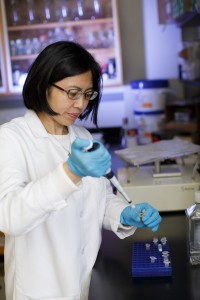05 Apr Mouse Model Shows Gene Therapy Can Reverse Blue Cone Vision Disorder
MedicalResearch.com Interview with:
Wen-Tao Deng, Ph.D.
Department of Ophthalmology, College of Medicine|
University of Florida, Gainesville, FL
MedicalResearch.com: What is the background for this study? What are the main findings?
Response: Blue cone monochromay (BCM) is a devastating vision disorder characterized by loss function of both L- and M-cones due to mutations in the L- and M-opin gene cluster on the X chromosome. BCM patients display severely reduced visual acuity, loss of color-vision, myopia, nystagmus, and minimally detectable cone-mediated electroretinogram. In our studies, we showed that an M-opsin knockout mouse model resembles human BCM, and expression of either human M- or L-opsin individually or combined through adeno-associated viral vector promotes regrowth of cone outer segments and rescues M-cone function in the treated M-opsin dorsal retin
MedicalResearch.com: What should readers take away from your report?
Response: Our research demonstrated proof-of-principle that a newly added opsin protein can structurally and functional rescue the defective cone cells in mice.
MedicalResearch.com: What recommendations do you have for future research as a result of this work?
Response: Further research is needed to optimize the treatment strategy, such as using a AAV capsid with higher penetrating property, that way enough vectors can reach photoreceptor cells by intravitreal injection to avoid detaching the retina caused by subretinal injection, the method used in current study. It was found by previous studies that detaching retina, especially fovea where most M-and L-cones are localized, can cause damage.
MedicalResearch.com: Is there anything else you would like to add?
Response: Dr. William W Hauswirth and the University of Florida have a financial interest in the use of AAV therapies, and WWH owns equity in a company (AGTC Inc.) that might, in the future, commercialize some aspects of this work.
Citations:
[wysija_form id=”3″]
The information on MedicalResearch.com is provided for educational purposes only, and is in no way intended to diagnose, cure, or treat any medical or other condition. Always seek the advice of your physician or other qualified health and ask your doctor any questions you may have regarding a medical condition. In addition to all other limitations and disclaimers in this agreement, service provider and its third party providers disclaim any liability or loss in connection with the content provided on this website.
Last Updated on April 5, 2018 by Marie Benz MD FAAD

